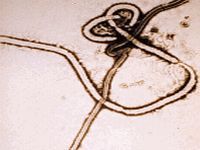Ebola virus waning?
The worst ever outbreak of Ebola virus in West Africa appears to be declining in Guinea, according to the latest statistics from the World Health Organization, which reveal that only one new case of Ebola Virus Disease (EVD) has been reported by the end of last week. However, the situation in Liberia and Sierra Leone is described as "an epidemic trend".

The statistics of this outbreak underline just how virulent Ebola Virus Disease is: In the Republic of Guinea, 309 deaths from 409 cases; in Liberia, 88 deaths from 142 cases; in Sierra Leone 142 deaths from 337 cases, a total of 539 deaths from 888 cases, a mortality rate of over sixty per cent.
From July 6 to 8, according to the World Health Organization, there were a total of 44 new cases of EVD, including 21 deaths. In Guinea, there was one new case and two deaths, in Liberia, 11 new cases and 4 deaths and in Sierra Leone, 32 cases and 15 deaths. The cases reported include confirmed, probable and suspected cases.
While the trend in Guinea creates some optimism (one new case reported in what has been to date the epicenter of the disease; the outbreak is thought to have been caused by consumption of the harvest of bats from the dense forests, to be sold dried in markets), the WHO describes the situation in Liberia and Sierra Leone as follows: "The epidemic trend in Liberia and Sierra Leone remains precarious with high numbers of new cases and deaths being reported. The current active foci of the EVD outbreak have been identified as Kailahun and Kenema in Sierra Leone and Lofa and Montserrado in Liberia".
Ebola Virus Disease
The death rate of EVD can reach up to 90%. It was first discovered in 1976 in the Democratic Republic of Congo in a village near the river Ebola. Affecting humans and primates, the most likely carrier or origin is the fruit bat.
Symptoms appear within two to 21 days after infection, which is caused by coming into contact with the body fluids of the victim or by eating infected meat (bushmeat, namely primates or bats, is considered a delicacy in parts of Africa). The onset is usually signaled by a fever, weakness, pain in the joints and muscles, headache, sore throat, then diarrhea, vomiting, a rash on the skin, liver and kidney damage and internal and external hemorrhages, bleeding from the ears, nose, eyes, mouth or even skin.
Patients are contagious as soon as the symptoms appear and remain contagious even after death, the reason why many infections are caused by the practice of placing the hands on the body of the deceased to pay last respects.
There is no approved virus or medicine available, the healthcare procedure being limited to supporting the patient while the body deals with the disease. Or not.
Timothy Bancroft-Hinchey
Pravda.Ru
Subscribe to Pravda.Ru Telegram channel, Facebook, RSS!





